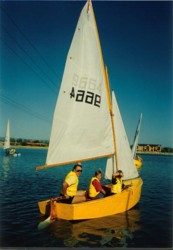Heron (dinghy)
 Learning to sail in a Heron, West Lakes, South Australia
+ | |
| Crew | 2 (max) |
|---|---|
| Boat | |
| Crew | 2 (max) |
| Hull | |
| Hull weight | 63.7 kg (140 lb) |
| LOA | 3.429 m (11.25 ft) |
| Beam | 1.372 m (4 ft 6.0 in) |
| Sails | |
| Mainsail area | 4.78 m2 (51.5 sq ft) |
| Jib/genoa area | Jib: 1.72 m2 (18.5 sq ft) Genoa: 2.83 m2 (30.5 sq ft) |
| Spinnaker area | 6.36 m2 (68.5 sq ft) |
| Racing | |
| D-PN | 120.0 |
| RYA PN | 1346 |
The Heron Dinghy is a dinghy designed by Jack Holt of the United Kingdom as the Yachting World Cartopper (YW Cartopper). The Heron dinghy was designed to be built by a home handyman out of marine ply over a timber frame, but can now also be constructed from marine ply using a stitch and glue technique or from Fibreglass. Modern dinghies will usually have built in buoyancy tanks, older craft will have bags or retrofitted tanks.
Since about 1980 boats have been increasingly made of Fibreglass, although the Australian association has approved stitch and glue construction .
The Heron is sailed in the UK and Australia and New Zealand, with a few others spread around the world. UK class rules vary slightly from the Australian Rules. In the UK a spinnaker is permitted and a larger genoa can be used. The UK also permits the use of different rudder shapes and a Bermudan Mast. Other more minor differences exist between the rules.[1] The Heron cartop dinghy was popular in Ireland from the late 1950s until the arrival of the Mirror which was lighter, easier to build, and had built in buoyancy.[2]
They are mainly used as adult/child racing dinghies. For state and national titles the Olympic triangle course is often used.
The Heron has a Portsmouth Yardstick of 1346 when sailed single handed.[3] In the US Sailing scheme it has a D-PN of 120.0.[4] The Heron has been a popular entry-level sailing dinghy, due largely to its high level of stability. The craft design features hard chines. These are sharp angles between the sides and bottom of the hull, giving it great stability even in rough weather conditions. This makes it easier for a relative novice to avoid capsizing. A round-hulled craft requires a lot more skill to keep upright.
The stability of Herons was demonstrated in South Australia on 26 January 1995. Forty-four yachts competing in a state title heat being held at the Largs Bay Sailing Club were struck by a violent thunder squall that lashed and wreaked widespread destruction across the city of Adelaide and surrounding districts. Winds speeds were reported in excess of sixty knots.[5] Although almost all yachts capsized immediately, two of the fleet remained upright and were surfed into shore, having had their masts broken before capsize could occur. 'Hot Eclipse' (sail no. 9299, skipper Gareth Eastwood) was at a point adjacent the windward jibe buoy around two kilometers offshore when the gale struck. It was manhandled to shore atop waves around four meters high, with the forward crew leaning across the front deck holding the sails down. The wild ride to safety lasted about an hour. Few small sailing dinghy designs could have managed this.
Over 10,200 Heron sail numbers have been issued since the design first appeared in the late 1950s.[6]
The first Heron, No 1 Flook still exists and is now owned by the National Maritime Museum Cornwall.[7]
References[]
- ^ UK Heron Association Archived 9 July 2009 at the Wayback Machine
- ^ I sailed in the Dublin Bay fleet and at regional events in Skerries, Howth, and Cork Harbour during that period
- ^ "Portsmouth Number List 2012". Royal Yachting Association. Retrieved 31 July 2012.
- ^ "Centerboard Classes-Inactive". US Sailing. Archived from the original on 16 August 2012. Retrieved 31 July 2012.
- ^ The Advertiser Newspaper
- ^ http://www.heron.yachting.org.au/[dead link]
- ^ Heron #1 "Flook" – BC08 www.nmmc.co.uk, accessed 11 November 2020
External links[]
UK heron Dinghy Class Association:
National Heron Sailing Association of Australia:
National Maritime Museum Cornwall
| Wikimedia Commons has media related to Heron (dinghy). |
- Dinghies
- Boats designed by Jack Holt